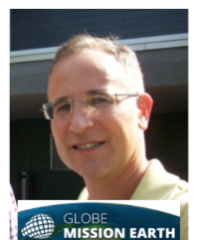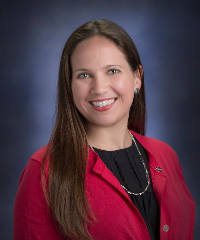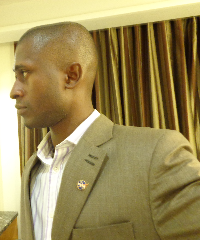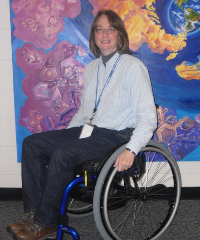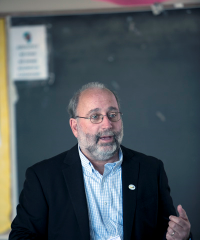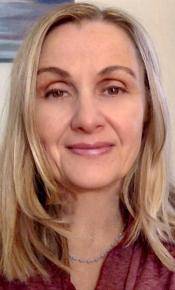GISN & STEM Professional's Blog - GLOBE International STEM Network
GISN & STEM Professional's Blog
The GLOBE International STEM Network (GISN) and STEM Professional's Blog is an online collaborative effort where scientists associated with GLOBE post their thoughts, comments, and philosophies about a variety of science topics.
GLOBE strongly encourages positive and productive discussions to further advance the scientific understanding of all involved with The GLOBE Program.
Filter By:
Blogs List
We are in the middle of our December observations for the Urban Heat Island Effect/Surface Temperature Field Campaign. 69 schools have entered 1323 observations. As developer of the surface temperature protocol I wanted to thank everyone who has taken observations . It is your data that will allow other students to create interesting research projects as well as providing a database for me and my students to conduct research. We have schools all over the world taking surface temperature observations to contribute to the campaign. I want to talk about problems some schools are having ...
Read More »
Posted in:
The GLOBE Clouds team loves coming up with ways to help students and teachers identify clouds. I've been blessed to visit a number of 4th grade full inclusion classrooms and want to share my quick cloud ID and data collection activity outline!
Anchor question: Do all clouds look the same, even from space?
Goal: Students identify, collect and submit cloud observations by using their own notes and clues for each possible cloud type.
Objectives: Students will,
(A) Recognize that clouds are part of the water cycle.
(B) Investigate cloud types ...
Posted in:
Curriculum:
STEM
GLOBE Science Topics:
SCIENTIST SKILLS
GLOBE PROTOCOLS
Learning Activities:
ATMOSPHERE AND CLIMATE
Primary Audience:
TRAINERS
TEACHERS
Teacher's Guide:
UPPER PRIMARY: 3-5
RESOURCES
The GLOBE Clouds team at NASA Langley Research Center in Hampton, VA would like to highlight the top observers of 2017! Thank you to all observers for submitting your observations and using the satellite matching of data.
Top 10 cloud observers for 2017
Observer
School
Country
Total Observations
Valentina Langiene
Zemynos pro-gimnazium
Lithuania
1201
Ahmad Alhefzi
As-Siddiq Secondary School at ...
Posted in:
By Olawale Oluwafemi (Femi), (Nigerian Space Agency) and DeStaerke Danielle (CNES)
The primary objective of every research project is not only about what you discover but also how do you communicate your discoveries to the interested audience. Delivering either a poster or oral presentation at a scientific meeting is not an easy task, but my passionate friend Danielle and I will present tips that will assist GLOBE Students and Teachers to deliver good scientific presentations.
Plate 1: Femi delivering poster presentation during GLOBE Annual Meeting at Estes Park, ...
Posted in:
Curriculum:
STEM
EDUCATION RESEARCH
Event Topics:
GLOBE LEARNING EXPEDITIONS
SCIENCE SYMPOSIA AND FAIRS
COMPETITIONS
GLOBE Science Topics:
MEETINGS/CONFERENCES
GLOBE Working Groups:
SCIENCE WORKING GROUP
EDUCATION WORKING GROUP
News Topics:
VIRTUAL SCIENCE FAIR
MEETINGS
Primary Audience:
TRAINERS
TEACHERS
STUDENTS
SCIENTISTS
Learning science involves learning important concepts, conducting experiments to see first-hand how researchers discovered and confirmed some elements of science concepts, and learning how to think scientifically. With this complete approach to learning science, students are well-prepared to deal with the natural world around them and to make wise decisions when confronted with various choices. The ability to think scientifically is a valuable skill in almost all aspects of life and doing science teaches scientific habits of mind.
Students can do science through research projects ...
Posted in:
Curriculum:
STEM
SCIENCE AND MATH
GLOBE Science Topics:
SCIENTIST SKILLS
GENERAL SCIENCE
BACKYARD SCIENCE
GLOBE Working Groups:
SCIENCE WORKING GROUP
Investigation Areas:
ATMOSPHERE
EARTH AS A SYSTEM
HYDROSPHERE
PEDOSPHERE (SOIL)
BIOSPHERE
News Topics:
VIRTUAL SCIENCE FAIR
COMPETITIONS
Primary Audience:
TEACHERS
STUDENTS
PARTNERS
COUNTRY COORDINATORS
Gathering data
Once you have determined what protocols to use for your project, you will need to develop a plan for gathering the data. It might consist of using automated data collection or making your own measurements. Also, it may include finding data taken by others, such as when you compare your observations with those of another GLOBE school.
Automated Data Collection
If you are using an automated data collection device or devices, verify that the data are being recorded properly before your official testing timeframe. You will want to monitor that the data are being ...
Posted in:
Curriculum:
STEM
EDUCATION RESEARCH
SCIENCE AND MATH
TECHNOLOGY
Event Topics:
SCIENCE SYMPOSIA AND FAIRS
GLOBE Science Topics:
SCIENTIST SKILLS
MEETINGS/CONFERENCES
GLOBE Working Groups:
SCIENCE WORKING GROUP
EDUCATION WORKING GROUP
News Topics:
VIRTUAL SCIENCE FAIR
Primary Audience:
TEACHERS
STUDENTS
Teacher's Guide:
SECONDARY: 9-12
MIDDLE: 6-8
Exciting new VR and AR applications of Geovisualizations are be developed at the Institute for Earth Observations at Palmyra Cove. You can check a quick demo on our Partnership's website www.palmyracove.org or take a look at the Mission Earth webinar @ https://www.youtube.com/watch?v=nCgntUpqcFg
Posted in:
The Urban Heat Island field campaign October version turned out to be a great success. Many schools took observations and entered them onto the GLOBE website. Remember, we are looking at the urban heat island in the seasons, October, December and March. Forty-three schools entered data in the month of October. If you haven't entered your data yet, please do soon. You can see on the map below that there were observations taken across the world. The size of the dot represents the total number of observations taken at the site. There has been great participation from Saudi Arabia, ...
Posted in:
Having students collaborate on projects has been a great potential of the GLOBE Program. Through GLOBE Mission EARTH, students in Detroit, Michigan and Shageluk, Alaska interacted over the Internet. Their teachers worked together with GLOBE Mission EARTH to plan the exchange.
Students from Randy Smith Middle School, Fairbanks, Alaska, Carol Scott.
Thirkell Elementary School 5th grade, Detroit Michigan - Teacher Connie Atkisson
Students were asked to generate questions to ask each other before the web meeting. They found that their houses were very similar. The ...
Posted in:
Authors: Claudia Caro and Olawale Oluwafemi (Femi)
Our participation in the International Virtual Science Symposium (IVSS) as judges has allowed us to learn more about the scientific experiences of students involved in the GLOBE Program. As members of the GLOBE Science Working Group with backgrounds in Geography and Biology, we would like to share our findings about the importance of the IVSS in the GLOBE community and give you some advice to empower your participation in this extraordinary yearly event.
Why an International Virtual Science Symposium?
Knowledge ...
Posted in:
Curriculum:
STEM
SCIENCE AND MATH
TECHNOLOGY
Event Topics:
SCIENCE SYMPOSIA AND FAIRS
GLOBE Working Groups:
SCIENCE WORKING GROUP
EDUCATION WORKING GROUP
Primary Audience:
TEACHERS
STUDENTS
COUNTRY COORDINATORS
Teacher's Guide:
SECONDARY: 9-12
MIDDLE: 6-8
GRADE LEVELS
When you start writing your GLOBE report for IVSS, it might be difficult because you might not sure where to start. We tend to start writing the Methods section first because it is something you did it yourselves and it should be relatively easy and straight forward to write. Second, you should write the Results section, do graphs, tables and texts (think of a best way to present your cool data to the whole world). Third, you should start writing the Introduction stating your hypotheses and predictions. The next step would be the Discussion section. It is funny to say but as scientists, ...
Posted in:
Curriculum:
STEM
EDUCATION RESEARCH
SCIENCE AND MATH
TECHNOLOGY
Event Topics:
MEETINGS
SCIENCE SYMPOSIA AND FAIRS
GLOBE Science Topics:
SCIENTIST SKILLS
MEETINGS/CONFERENCES
GLOBE Working Groups:
SCIENCE WORKING GROUP
EDUCATION WORKING GROUP
News Topics:
VIRTUAL SCIENCE FAIR
Primary Audience:
TEACHERS
STUDENTS
Teacher's Guide:
GRADE LEVELS
SECONDARY: 9-12
MIDDLE: 6-8
https://earthengine.google.com/timelapse/#v=52.02687,-9.54373,10.654,latLng&t=3.20
Posted in:
Observations of daily precipitation have been a part of GLOBE from the beginning. At the start, GLOBE’s participation model was that schools would take measurement following all of the original 17 protocols. Atmosphere temperature, precipitation, cloud, and soil moisture measurements were to be collected daily at a site easily accessible to the school. A permanent installation of an instrument shelter containing a max/min thermometer mounted to a post along with a rain gauge was the expected norm with other measurements taken nearby. Daily temperature and precipitation measurements were ...
Posted in:
Field Campaigns:
EL NIÑO
GPM
GLOBE Science Topics:
GLOBE PROTOCOLS
GLOBE Working Groups:
SCIENCE WORKING GROUP
EDUCATION WORKING GROUP
Investigation Areas:
ATMOSPHERE
Primary Audience:
TRAINERS
TEACHERS
STUDENTS
PARTNERS
COUNTRY COORDINATORS
Teacher's Guide:
DOCUMENT TYPES
From the start, the measurement of daily maximum and minimum air temperature within one hour of local solar noon has been a key GLOBE protocol. The low cost approach was to use a U-tube thermometer housed in a wooden instrument shelter facing away from the equator. The U-shaped tube contained mercury with pins on either side of the mercury. As the air temperature warmed the pin on one side would move while the other pin stayed in place; when the air cooled, the pin on the other side would be pushed up. The pins were held in place by magnetized strips behind the thermometer tube so that ...
Posted in:
Curriculum:
STEM
TECHNOLOGY
GLOBE Science Topics:
EARTH AS A SYSTEM
EARTH SYSTEM SCIENCE
GLOBE PROTOCOLS
CLIMATE CHANGE
CLIMATE
GLOBE Working Groups:
SCIENCE WORKING GROUP
Investigation Areas:
ATMOSPHERE
Primary Audience:
TEACHERS
TRAINERS
STUDENTS
PARTNERS
SCIENTISTS
ALUMNI
COUNTRY COORDINATORS
As Earth science has a single uncontrolled object of study, the first rule is to take today’s data today. While ice and sediment cores and fossils can reveal past conditions, the observations that can be made right now cannot be replaced by ones taken later. This goes well with the Native American adage, “You can’t step in the same river twice.” The environment is constantly changing and doing so on a wide range of time and space scales.
In a recent video post, Neil deGrasse Tyson said,
“One of the great things about science is that it is an entire exercise finding what is true. You ...
Posted in:
Curriculum:
SCIENCE AND MATH
Event Topics:
CAMPAIGNS AND PROJECTS (IOPS, ETC)
GLOBE LEARNING EXPEDITIONS
SCIENCE SYMPOSIA AND FAIRS
Field Campaigns:
EL NIÑO
SMAP
GLOBE Science Topics:
EARTH AS A SYSTEM
EARTH SYSTEM SCIENCE
GENERAL SCIENCE
CLIMATE CHANGE
CLIMATE
Investigation Areas:
EARTH AS A SYSTEM
Primary Audience:
TEACHERS
STUDENTS
ALUMNI
In the fall of 2016, the students in my Weather and Climate class, GEPL 4490/5490, at the University of Toledo developed projects based on El Nino. The students in class were give the task to look at GLOBE data from a part of the world in which El Nino has an effect. The students were also tasked to do research on El Nino and La Nina to see what it is.
The students looked at the following locations:
Taiwan 2015 – Nicole Jablonski, Bailey Hafner, Cortnee Halpin
Japan 1998 – Sean Smith,
Australia 1998 – Madhusanka Jayawardhana, Josh Coll, and Justin Maluchnik ...
Posted in:
Consider the rain gauge used in GLOBE, CoCoRaHS, and other citizen science programs. Just four pieces plus 2 mounting screws – an inner graduated cylinder, an outer cylinder, a cap/funnel, and a mounting bracket. The area of the outer tube is exactly 10 times the areas of the inner tube and the cap/funnel, so the graduations on the inner cylinder can be spaced ten times further apart. Thus, 0.2 mm of rain fills the inner tube to a depth of 2.0 mm, which one can read.
In addition, if heavy rainfall fills the inner cylinder, the rest of the rainfall overflows into the outer cylinder, ...
Posted in:
Curriculum:
STEM
Field Campaigns:
EL NIÑO
GPM
GLOBE Science Topics:
BACKYARD SCIENCE
GLOBE PROTOCOLS
Investigation Areas:
ATMOSPHERE
Primary Audience:
TEACHERS
STUDENTS
ALUMNI
Hello GLOBE friends!
The Evaluation Working Group has recently shared with you the results of the 2015 survey that was sent to the GLOBE teachers. The results from this survey, along with the results from the Annual Partner Survey provided us with useful information as to how to better support GLOBE in the classroom. Among other things,. the feedback we had from the teachers was that they are asking for evaluation tools they can use in their classrooms and for guidance on how to use these tools.
During our discussions in the Working Group we thought about this ...
Posted in:
This time was my first visit to Trinidad and Tobago and to the LAC region. The visit was first of its kinds, knowing vividly that Africans and the People of Trinidad and Tobago have so many things in common in terms of Geography and Historical antecedent. The motivation for my visit to Trinidad and Tobago started during the 17 th GLOBE Annual meeting at Maryland. Initially, it was just a brief discussion with Henry Saunders (Country Coordinator, GLOBE Trinidad and Tobago). However, after a year, I met Mr. Michael at GLOBE Expedition in New Delhi, India where we had in-depth ...
Posted in:
GLOBE Science Topics:
MEETINGS/CONFERENCES
GLOBE Working Groups:
SCIENCE WORKING GROUP
Investigation Areas:
PEDOSPHERE (SOIL)
Primary Audience:
TEACHERS
STUDENTS
SCIENTISTS
ALUMNI
COUNTRY COORDINATORS
Concerns regarding the impact of global warming on vector-borne diseases have intensified interest in the relationship between atmospheric factors and dengue fever incidence. Global climate change poses the threat of serious social upheaval, population displacement, economic hardships, and environmental degradation. Changes in temperature, rainfall and relative humidity have potential to enhance vector development, reproductive and biting rates, shorten pathogen incubation period and encourage adult longevity. In addition, changes in wind direction, velocity and frequency will have an ...
Posted in:
GLOBE Science Topics:
CLIMATE CHANGE
GLOBE PROTOCOLS
Investigation Areas:
HYDROSPHERE
Learning Activities:
HYDROLOGY
Primary Audience:
TEACHERS
STUDENTS
—
20 Items per Page






